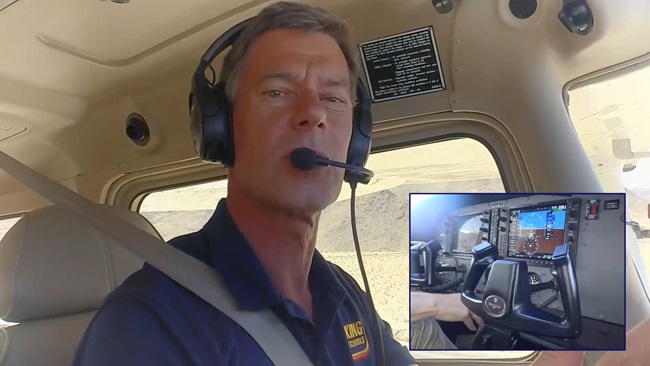Master the rudder, master the landing
 You’ve heard this sad tale before: Forty hours of dual instruction, with more than 200 logged landings—and Bobby still can’t land an airplane. Bobby is in such despair that his instructor resorts to special motivational phrases to buoy his student’s spirits: “OK, Bobby, not bad. You’re missing the runway closer now.” Oy vey!
You’ve heard this sad tale before: Forty hours of dual instruction, with more than 200 logged landings—and Bobby still can’t land an airplane. Bobby is in such despair that his instructor resorts to special motivational phrases to buoy his student’s spirits: “OK, Bobby, not bad. You’re missing the runway closer now.” Oy vey!
Why would someone with more than 200 landings be unable to land an airplane? If we assume average intelligence, and reflexes fast enough to avoid an onrushing glacier, learning to land shouldn’t be difficult at all. What is going on here?
Let me explain by taking you back in time, about 76 years. In 1940, the Civil Aeronautics Administration (CAA) conducted an experiment to determine the average time required for “zero-time” students, ranging in age from 18 to 46 years, to solo an airplane. These students, who came from all walks of life, were divided into two groups. One group trained in a Piper Cub having conventional gear (conventional for that time period). The other trained in Fred Weick’s recently created Ercoupe. The Ercoupe was the first small airplane to have tricycle gear, which was unconventional for its time. It also had a two-axis control system (i.e., no rudder pedals) that coordinated both rudder and aileron control movement.
The CAA experiment revealed that the students training in the Piper Cub took approximately eight hours to solo, while those training in the Ercoupe soloed in 4.3 hours. One student even soloed in 2.2 hours in the Ercoupe. (Years ago I soloed a zero-time student in an Ercoupe in 4.5 hours, at a tower-controlled airport.) Apparently, when rudder pedals weren’t needed to fly an airplane, learning to fly became amazingly easy. The results of this experiment even motivated the CAA (at that time) to reduce the private pilot certificate requirements in a two-axis-control airplane from 32 to 25 hours.
Of course, you might argue that taildraggers are more challenging to land than tricycle-gear airplanes. That’s true. However, until the main wheels of both types of landing gear touch the runway, the control inputs required to round out and flare either airplane are essentially the same (assuming you touch down close to stall speed). The real challenge with landing a taildragger is using the rudder pedals to keep the airplane’s nose pointed straight down the runway after touchdown—which isn’t an issue in an Ercoupe. Therefore, it’s the need for rudder usage—on the ground and in the air—that makes the Cub more challenging to land than the Ercoupe.
The CAA’s experiment suggests that learning how to round out and flare is not the main challenge students face prior to solo. After all, students in the Ercoupe probably spent 2.1 hours in the practice area and 2.2 hours in the pattern learning to land. Those 2.2 hours most likely result in an average of 20 touch-and-go landings before solo. Cub students most likely needed four hours of landing practice prior to solo. Here’s the conclusion I’d draw from this observation: Almost any student can learn to land an Ercoupe in a little more than two hours. Students also can do the same thing in a tricycle-gear airplane equipped with rudder pedals, but only if they have developed good rudder skills before they begin landing practice.
Without good rudder skills, students in three-axis-control airplanes can’t control the direction the airplane’s nose points while landing. Now they must divide their conscious attention between keeping the airplane over the runway and controlling their height above it. Good rudder skills acquired before landing practice begins allow students to focus all of their attention on learning how to round out and flare.
The wonderful news is that anyone, students or rated pilots, can acquire reflexive rudder skills on a desktop flight simulator that has a yoke and rudder pedals. Begin by setting the simulated airplane on a half-mile final at 500 feet agl at approach speed. Select severe turbulence and maximum allowable runway-aligned winds from the weather menu, and uncheck the auto-coordination feature. Save this simulation for repeated use.
Get to it. Practice flying. Keep the wings level with the ailerons, and the nose straight with the coordinated use of the rudder as you descend for landing. Right aileron, right rudder; left aileron, left rudder. No exceptions. Repeat the sequence over and over again in a “wax on/wax off” manner until your legs fall off (or you get tired, whichever hurts less). You’ll know you’ve acquired basic rudder skills when you level a turbulence-displaced wing and the nose doesn’t yaw one micron. Now you’re ready to set foot in an airplane—assuming your foot is still attached, of course.
Web: www.rodmachado.com
Rod Machado learned to fly in a Taylorcraft L–2.



